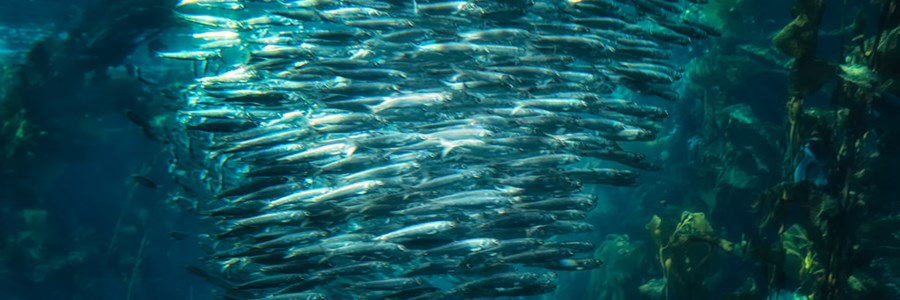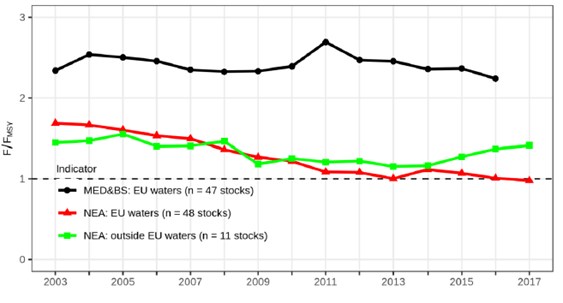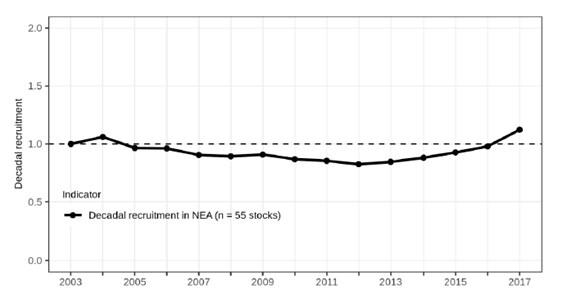36% more fish in the sea in only ten years

This was one of the main results from the European Scientific, Technical and Economic Committee for Fisheries (STECF) annual report1 on the performance of the Common Fisheries Policy (CFP), particularly concerning the progress towards achieving sustainable fisheries. The scientific report shows that the stock status has significantly improved in the North-East Atlantic with an overall downward trend in the fishing pressure over the period 2003-2017. As a consequence, fish populations have been generally increasing since 2007, reaching in 2017 levels 36% higher than in 2003. However, further efforts are still needed, particularly in the Mediterranean.
The STECF is the European Commission's scientific body which provides independent scientific advice for the conservation and management of living marine resources, including biological, economic, environmental, social and technical considerations. This allows policy-makers to build their decisions based on solid science evidence, better understand the health of a stock, determine how much can be fished, and closely monitor the implementation of the CFP.
The STECF report evidences overall positive trends for many fish stocks in the ecoregions across Europe. This is clearly confirmed by the fact that in the North-East Atlantic the proportion of overexploited stocks was reduced almost by half over the last decade. The proportion of stocks outside safe biological limits shows a similar downward trend under the same period. The good news in these waters do not end here, as the recruitment trend shows that the number of young fish entering the stocks is consistently increasing since 2012, which explains the increase in stock’s production.
Managing Director, Daniel Voces, declared: “After years of hard work and sacrifices, we welcome the fact that the fish stocks are growing year after year. The scientific data presented proves a drastic reduction in fishing pressure in the North-East Atlantic which is now stabilizing at sustainable levels. The EU has successfully managed to sustainably regulate the big stocks in EU waters while making good progress on numerous small stocks. This is clearly reflected in the fact that for the Baltic, North Western Waters, South Western waters, and North Sea, for the stocks managed by the EU alone, almost 100% of the landings come from catches fished at the highest level of sustainability in line with the Maximum Sustainable Yield (MSY) policy.”
Insisting on the importance to focus efforts on the sustainable management of large fish stocks, Europêche recalls that currently 86% of the global total tuna catch comes from stocks at healthy levels.
By way of contrast, Europêche regrets that the positive news of the STCEF report is yet again transformed by the NGO community into another outburst of end-of-the-world prophecies. While the fishing industry has made many sacrifices and efforts to comply with the ambitious objectives of the CFP, standing on the sidelines predicting extinction does not help at all. Just to give an example, despite the enlargements of the EU, the number of EU vessels in 2015 was 85 154, 18 693 fewer than in 1996. Europêche considers it frustrating to read the catastrophic messages of gloom and doom that do not recognize the good progress which not only jeopardises the industry’s work with scientists and governments but also confuses consumers.
Mr Voces concluded: “For the majority of the stocks in the North-East Atlantic, the end of overfishing has become a reality and is now demonstrated by science. However, maintaining fish stocks at sustainable levels will remain a challenge since interactions among the stocks, such as predator-prey-relationships, pollution or climate change are becoming a fundamental factor for the status of the fish populations. These challenges also make it extremely difficult or even impossible to reach MSY levels for all stocks simultaneously in the same area.”
In the Mediterranean and Black Seas, although many stocks remain overfished due to inadequate fishing pressure levels which peaked in 2011, they have ever since been showing a rather decreasing trend in the number of overexploited stocks. Consequently, since 2012, after years of unchanged fish population levels, the data regarding biomass displays as well a fairly increase.
The European fisheries policy success towards environmental sustainability opens the door for the improvement of the competiveness of the EU fleet and the much-needed modernisation of old vessels which is a must to enhance the safety, working and living conditions of fishing crews.
1 Monitoring the performance of the Common Fisheries Policy (STECF-Adhoc-19-01)
2 International Seafood Sustainability Foundation (ISSF) report, March 2019
Ends
Press contacts:
Rosalie Tukker, Policy Advisor of Europêche: +32 (0)2 230 48 48 rosalie.tukker@europeche.org
* The STECF graphs below illustrate the significant reduction of fishing pressure (F/FMSY), increase of biomass (B/B2003) and recruitment (R/R2003) respectively in the ecoregions indicated – The Mediterranean and Black Seas as MED&BS, and the North East Atlantic as NEA.



Sources: Europeche
Attachments:
Tags: STECF, CFP, fish stocks, biomass, MSY, North-East Atlantic, Mediterranean, Black Sea, ICES, european commission, fishing pressure, TAC, issf, recruitment